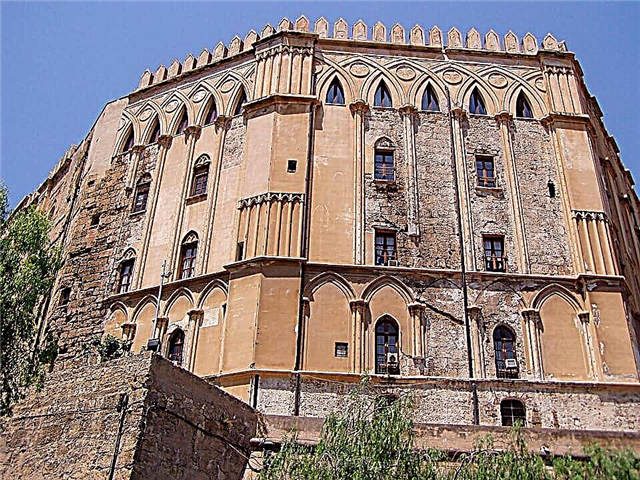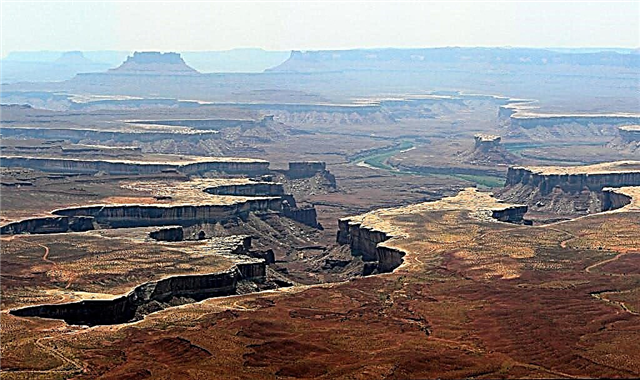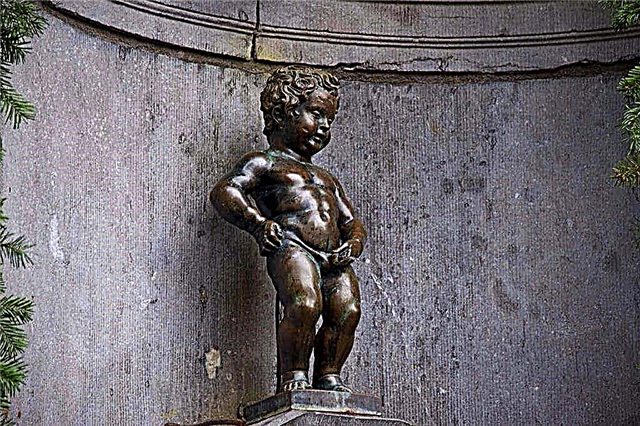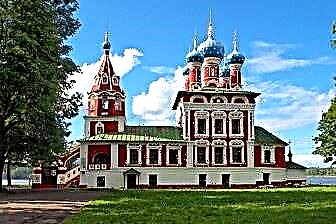The history of the ancient Russian city of Uglich goes back to the distant X century. In the XIII-XVI centuries, it was the center of the principality of the same name. One of the most famous and tragic events in its history was the murder of Tsarevich Dmitry, committed under strange, not fully disclosed circumstances.
Picturesque ancient churches of Uglich, monasteries and merchant estates create here a special atmosphere of the past centuries - it is not for nothing that the town is one of the most popular on the Golden Ring route and a stopping place for all cruise ships following the Volga. Another indisputable advantage of Uglich is a large number of small museums with unique collections that have appeared in the city thanks to its enthusiastic residents.

The best hotels and hotels at affordable prices.
from 500 rubles / day
What to see and where to go in Uglich?
The most interesting and beautiful places for walking. Photos and a short description.
Uglich Kremlin
The city Kremlin is a complex of buildings on the banks of the Volga. Historically, it was a fortified territory, surrounded by wooden fortress walls and earthen ramparts, but the defensive structures have not survived. Today, the Uglich Kremlin is an architectural ensemble consisting of the Transfiguration Cathedral, the building of the City Council, the Church of Demetrius and the princely chambers.

Church of Demetrius on the Blood
The picturesque temple on the banks of the Volga is one of the first buildings that tourists see on a cruise ship approaching the city. The stone building of the church was erected in 1692 on the site of the death of Tsarevich Dimitri (the youngest son of Ivan the Terrible). The facade of the building is painted in a symbolic red color, diluted with the snow-white shade of the window frames and the blue color of the domes.
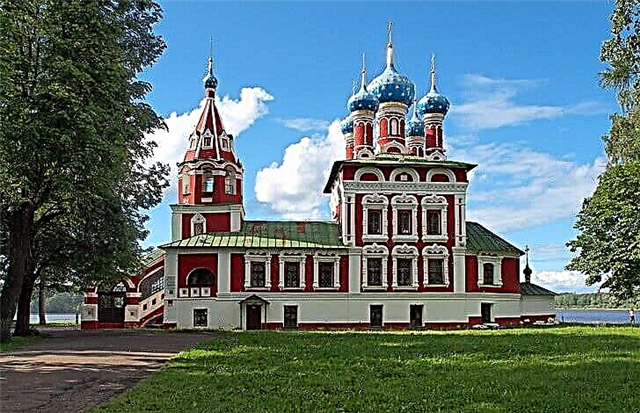
Transfiguration Cathedral
The Uglich Cathedral, built in 1710 to replace the wooden building. The facade of the building in the style of classicism was redone in the 19th century. At the same time, wall paintings were created. The cathedral bell tower is located separately from the main building, it was erected in 1730. It is made in the form of an octagonal tower crowned with a spire. Such architectural forms were widespread in the first half of the 18th century.

Epiphany (winter) cathedral
In the past, the Epiphany Cathedral was part of a large church, the main building of which was "cold", i.e. intended for summer worship. The stone winter church was built in 1827 for the possibility of holding services at any time of the year. The building has the shape of a basilica with a gable roof, which ends with a semicircular apse. The main façade is framed by a row of wide windows and pilasters. Nowadays, a museum with a collection of icons, noble and merchant portraits is located on the territory of the temple.

Chambers of Uglich princes
The princely palace of the 15th century, built during the reign of Prince Andrei Vasilievich Bolshoi. The complex is one of the oldest civil architecture structures in Russia. The chambers have three tiers; the first floor has almost completely sunk into the ground over the centuries. As a result of numerous reconstructions, only the chapel of the throne remained from the historical building, the rest of the parts were built in the 18th – 19th centuries.

Uglich History Museum
The exposition is located in a merchant's mansion. It was created by the efforts of the Uglich family of the Kulagins, whose members were seriously fond of local history and collected several hundred historical exhibits. The museum is small in size and consists of two departments. Visitors can view clothes, weapons, household items, city panoramas and models of historical structures.

Museum of Urban Life
An interesting and colorful collection is located in the wooden city manor. It is dedicated to the traditions, life and customs of the townspeople, which were in use in the XIX-XX centuries. Part of the exposition is a reconstruction of a living quarters that belonged to a wealthy merchant or bourgeoisie, with all the appropriate attributes - furniture, dishes, clothes. As part of the excursion program, guests are offered traditional Russian tea drinking and a theatrical performance.

Museum of the History of Hydropower of Russia
The exposition is dedicated to everything related to the hydropower sector: dams, dams, the construction of hydroelectric power plants, as well as the history and prospects of the development of the industry. The institution opened in 2007, four years later it was included in the list of the best regional museums in Russia. The collection occupies 11 rooms spread over three floors. Thanks to the many interactive exhibits, the exhibition looks lively and informative.

Museum of Prison Art
The institution was founded by a private person in 2004. The exhibition, located in two small rooms, is a collection of objects created by prisoners. It is known that people serving sentences make the most bizarre things from scrap materials to pass the time. Paper, sheets, bread crumb, wood are used. In the Uglich Museum you can see all these wonders.

Museum-gallery of dolls Olga Pavlycheva
Private collection of dolls created by craftswoman and artist Olga Pavlycheva. Literally from childhood, she led a circle where young artisans made toys from various materials. It was these children who later became prototypes for museum exhibits. Almost all dolls are made of papier-mâché, each figurine is individual and presented in a special way.

Museum of Myths and Superstitions of the Russian People
An unusual and even mystical exposition is located inside a two-story wooden house. It is a collection of works by one family of masters - everything that can be seen in the museum was created by the hands of the Aliens spouses. In the exhibition halls, visitors will be greeted by creepy characters: ghouls, ghouls, sorceresses, witches, goblin, brownies and other evil spirits.

Museum of the History of Russian Vodka
The museum opened in 1998. It became the first exhibition facility dedicated to the traditional spirits. It was not by chance that the exposition appeared in Uglich - the city is the birthplace of the vodka king and bitter inventor P. A. Smirnov. The collection includes moonshine stills, filling machines, old vessels, labels. The central place is occupied by a collection of several hundred varieties of vodka produced at enterprises throughout Russia.

House-Museum "Legends of Uglich"
The institution is located in a house owned by the industrialist A.K. Posnov, who made a fortune in the production of sausages and meat delicacies. The exposition, located in two rooms, tells about the real and fictional history of Uglich, as well as about its famous inhabitants. Here you can see a working telephone from 1900, an old grand piano, a gramophone and other interesting exhibits.

Museum of watches "Seagull"
The Uglich plant "Chaika" is a manufacturer of the famous Soviet watch brand, which stopped production in 2006. In the museum you can get acquainted with the history of the enterprise and see more than 3 thousand copies of chronometers produced at different times. The institution was created in 1975 in the building of the factory entrance. After a long hiatus, the museum opened its doors again in 2012.

Arsenal of unusual bicycles "Samokat"
The museum was opened in early 2017. Thus, it is the youngest exposition of Uglich. The collection is entirely dedicated to bicycles - here you can find old models of the 19th century, devices made of wood, and modern devices. The museum has a bike rental service where you can rent Soviet "Ural" or "Eaglet", as well as a regular bike to ride around Uglich.

Fire Tower
The building was erected in the 1830s. It is a two-story mansion with a mezzanine, decorated with a classic portico, and the fire tower itself. The building still houses the city fire brigade. In the 19th century, the territory of the building also housed the city administration, and a little later - the county and parish school.

Church of the Nativity of John the Baptist
Temple of the 17th century, built at the expense of the merchant N.G. Chepolosov. The merchant wished to build a church in memory of his young son Ivan, who was killed by the envious clerk Rudakov. In the 1960s, during the restoration, the boy's grave was found inside the temple. The artistic value of the building is so indisputable that even in Stalin's time, the design of the Uglich hydroelectric power station was changed to preserve it.

Kazan Church
The temple is located on the Assumption Square. Previously, there were two churches in its place - a wooden one and a stone one, destroyed during the fires. The church building that has survived to this day was erected in the second half of the 18th century, but it also burned twice, after which it underwent major reconstructions. In the fire of 1921, the most valuable relic, the icon of the Kazan Mother of God, was lost. After desolation in the XX century, the temple was revived again and today it is an adornment of Uglich.

Church of Tsarevich Demetrius "on the field"
One of the most picturesque temples in Uglich, the construction of which is associated with a legend. After the murder of the young Tsarevich Dmitry, they decided to send his body to Moscow. During the farewell divine liturgy in the open air on the outskirts of the city, a stream of blood spilled from the coffin. Drops with particles of earth were carefully collected and placed in a shrine, and in this place they decided to build a church. The preserved building of the temple of the 18th century is the heir of that first church.

Korsun Church
The church is located along the road leading from Yaroslavl. Since the 13th century, a monastery existed on this site, destroyed by the Poles during the Time of Troubles. When in the 18th century a new church was erected on the site of the burned-down buildings, they found a miraculously surviving icon of the Korsun Mother of God, in whose honor the throne was consecrated. The building was built in the Naryshkin Baroque style with elements of Russian architecture.

Resurrection monastery
The exact date of the foundation of the monastery is unknown - most experts agree that the monastic community was formed before the 15th century. The surviving complex of buildings, consisting of the Resurrection Cathedral, the bell tower, the refectory and the Hodegetria Church, was erected in the 1670s. In the 18th century, the monastery was abolished, and its churches served as parish churches. Major restoration of the ensemble took place in 1975.

Epiphany monastery
The women's monastery, first mentioned in the sources of the XIV century. It was founded by Evdokia - the wife of Prince Dmitry Donskoy. Initially, all the buildings of the complex were wooden, in the 17th – 18th centuries they were replaced by stone ones. Most of the buildings, including the nursing buildings, appeared in the 19th century during the period of the highest prosperity of the monastery. Monastic life revived in the 2000s after a 70-year hiatus.

Alekseevsky monastery
The Alekseevsk monastery was founded at the end of the XIV century by the monk Adrian with the blessing of Metropolitan Alexy, but during the Time of Troubles it was almost completely destroyed. After the expulsion of the Polish-Lithuanian invaders, the restoration of the Assumption Church (nicknamed "Wonderful" for its picturesque appearance) began. The entire monastery was gradually revived.

Uglich hydroelectric power station
The hydroelectric power plant was launched in 1940. In the Soviet Union, this was the first such structure, which in the future provided electricity to Moscow. At the moment, the facility is operational. The complex of buildings, consisting of a station building, a shipping lock and two dams, is recognized as an architectural heritage, therefore it is under state protection.

Shipping lock of the Uglich hydroelectric power station
The structure is part of the Uglich hydroelectric power station, it is adjacent to the left bank of the Volga (to the earthen dam). The width of the lock is 10 meters, it is filled with water to the required level in about 10 minutes, and emptied in 7. It consists of enclosing dams, a chamber, a quay wall and a shipping channel 1.2 km long. Cruise ships and industrial ships constantly pass through the lock.




